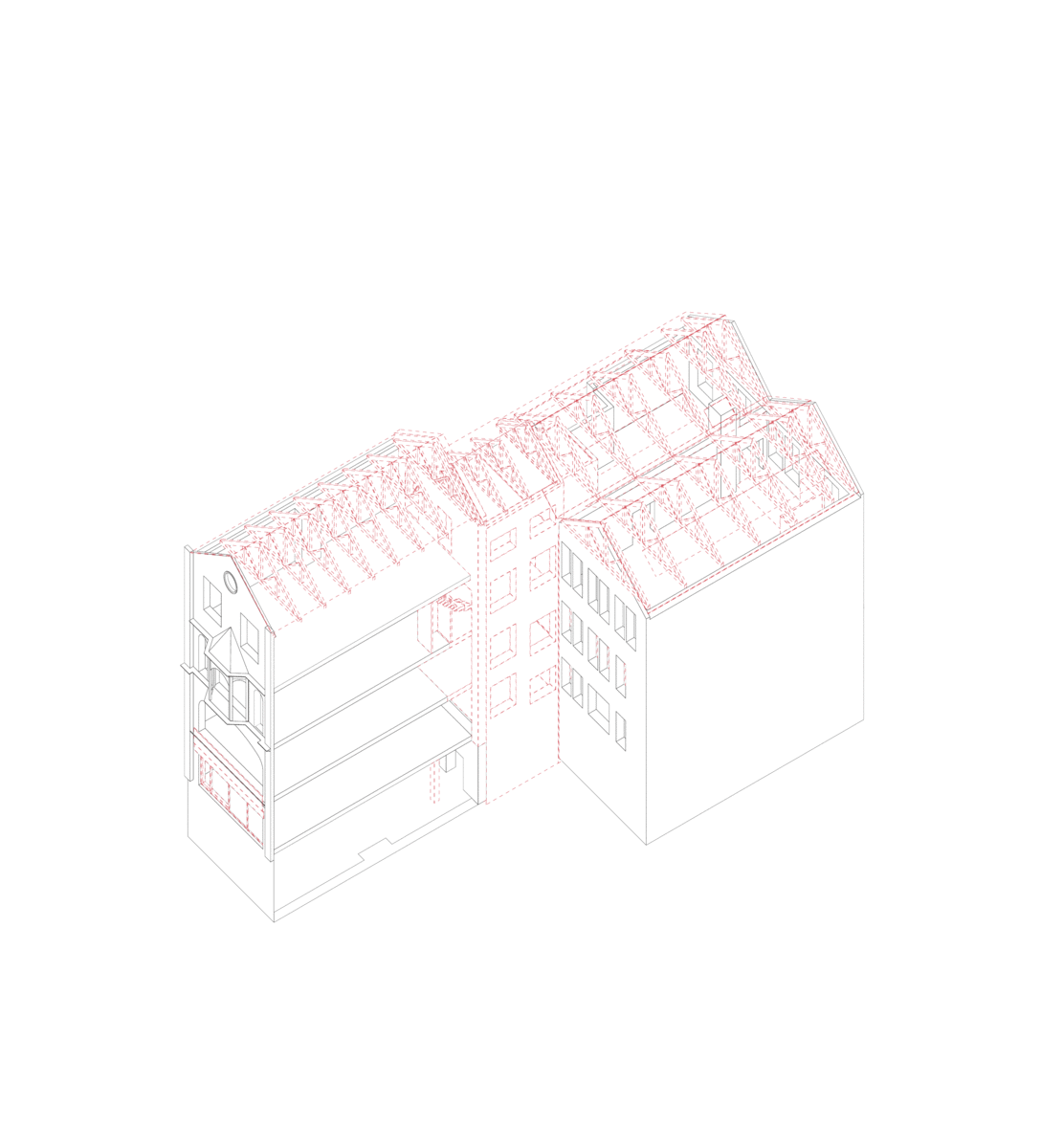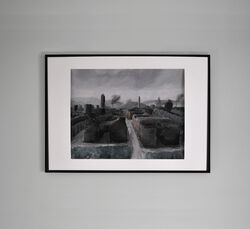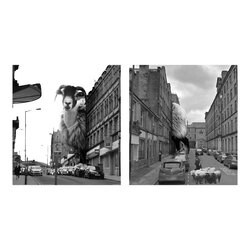Sheep, Industry and the City: Weaving a space of art production in Bradford
CiA PS2: 46 Darley Street
City to the landscape
As a final reflection on the project we completed a painted visual that captures the ethos and key themes of the project yet places our proposal in the wider context of Bradford. It was important for us to return to the first image shown that depicts the city from the fields and landscape that surrounds Bradford looking towards the city. Opposing this, the final image captures a view out to the hills, just past the industrial mills, from the city placing you within its context.
Acrylic on linen paper 410mm x 310mm
Jonathan Barker
Jamie Reed
Posted 7 Apr 2021 18:25
Sheep, Industry and the City: Weaving a space of art production in Bradford
CiA PS2: 46 Darley Street
Refining space (1:50 spatial model)
Developing a sectional model expresses this movement between spaces and gives a coherent understanding on how the spaces connect and weave together. As a spatial translation of the section it refines the details of inhabitation in the assignment of spaces in the building, capturing the nature of the act of demolition and creating a new circulation space as fulcrum which, directing people around and between the two separate sides of 46 Darley Street.
Jonathan Barker
Jamie Reed
Posted 7 Apr 2021 18:10
Sheep, Industry and the City: Weaving a space of art production in Bradford
CiA PS2: 46 Darley Street
Gallery Space: Repeating elements into form
A large part of the design development was the articulation of the roof truss system that would frame the upper galleries and flood light into the spaces below. The trusses had to be lightweight and airy to enable light to pass through but be dense enough to be read as a form or a room. This new intervention would then be place on the existing walls to highlight it lightweight nature.
Jonathan Barker
Jamie Reed
Posted 7 Apr 2021 18:08
Sheep, Industry and the City: Weaving a space of art production in Bradford
CiA PS2: 46 Darley Street
Attitude to detail: Roof truss iteration models (1:50, balsa)
Jonathan Barker
Jamie Reed
Posted 7 Apr 2021 18:06

Sheep, Industry and the City: Weaving a space of art production in Bradford
CiA PS2: 46 Darley Street
Construction sequencing
The construction sequencing for the new building requires firstly an in-depth audit and strategy for controlled demolition before any new ground work and foundations can be added. Once added and existing floors are supported by ackrow props, the new steel between floors can be installed to provide support at the end of the existing floors. Included in this steelwork is central steel staircase, this would be covered to provide protection as construction work continues.
After the steelwork is installed, the roof structure is fitted to ensure the building is watertight before any new finishings are installed. Once watertight, the new floors, new internal walls and finishings can be built. The last section to be built will be the light controlled gallery as the existing yard space will be needed for the aid of construction throughout the process.
Jonathan Barker
Jamie Reed
Posted 7 Apr 2021 18:03
Sheep, Industry and the City: Weaving a space of art production in Bradford
CiA PS2: 46 Darley Street
Collection of Axo’s: The External Gallery, The Stairwell and The Shopfront
Public entry into the building is accessed through a modest ‘shop front’ entrance. Moving through this space, and into the central space, the dramatic fulcrum space is revealed to the visitor as views up between each floor is observed. The ground floor also makes use of the yard space and roof of the light controlled gallery by providing an external gallery used for different external mediums of producing art such as large scale sculpture and murals.
Jonathan Barker
Jamie Reed
Posted 7 Apr 2021 17:54
Sheep, Industry and the City: Weaving a space of art production in Bradford
CiA PS2: 46 Darley Street
The act of controlled demolition: Adapting to create new space
What we also gained from the analysis of Carlo Scarpas Castelvecchio was his controlled use of demolition that allowed the Cangrande space to be revealed to the visitor. It encouraged thoughts on how demolition can be seen as a controlled activity, accentuated to reveal the historic and new interventions in the building.
As such, we took a controlled demolition strategy to understand what spaces we wanted to create through this act. Again, identifying weakness such as light and access in the existing building audit informed many decisions in the act of demolition.
Demolishing such a large part of the existing building was possible due to the disposable and relatively unimportant nature of the building. Not being listed, it provided greater scope what we could demolish.
Jonathan Barker
Jamie Reed
Posted 7 Apr 2021 17:49
Sheep, Industry and the City: Weaving a space of art production in Bradford
CiA PS2: 46 Darley Street
Splitting Stock: Assigning spaces
The next stage of our process involved splitting and assigning different uses and functions to the existing spaces in the building, alike the process of grading and sorting stock within wool production. We began by analysing each of the spaces and what they provided, much of the decision making was a result in seeing what the building wanted and understanding what space best suited the different functions needed in the art space.
Aiding the decision making, the existing building audit helped ‘grade’ a number of the existing spaces; dark areas such as the basement level could be assigned to ancillary spaces and toilets, upper levels that gave more light were assigned gallery spaces to make use of the flood of light taller spaces the roof provided.
Jonathan Barker
Jamie Reed
Posted 7 Apr 2021 17:44
Sheep, Industry and the City: Weaving a space of art production in Bradford
CiA PS2: 46 Darley Street
Space as fulcrum: Castelvecchio, Carlo Scarpa
Carlo Scarpa’s Castelvecchio in Verona uses the existing castle to express a knot of different periods of architecture and history in the celebration of the Cangrande space. Scarpa places the Cangrande sculpture to express it’s importance and, through his architectural intervention, creates a fulcrum space. The building allows the visitor to move around the statue through a web of circulation that brings you right up to the artwork.
Jonathan Barker
Jamie Reed
Posted 7 Apr 2021 17:40
Sheep, Industry and the City: Weaving a space of art production in Bradford
CiA PS2: 46 Darley Street
Inquisition of space: Front and Back
To begin our investigation on a new inquisition of art space in Bradford, we returned to early images of sheep wondering the streets, envisaging 46 Darley Street as one of these sheep within the heard. The exploratory photomontage provoked thought on the public presence of each facade, Darley street providing more welcoming civic presence through its ornament, while the Piccadilly side looked to be the working area, or the ‘back end’ of the building.
Jonathan Barker
Jamie Reed
Posted 7 Apr 2021 14:22
Sheep, Industry and the City: Weaving a space of art production in Bradford
CiA PS2: 46 Darley Street
Triptych: The former inhabitants of Bradford
The connection between settlement and industry should be commonly referred to when talking about the textile boom. We looked at how sheep might inhabit the city today as a way of reclaiming their land. Placing the animals awkwardly between and behind different buildings to provide an almost dystopian Bradford. It marked the start of the project and the process of producing textiles in the city, this kick-started our interest in this process which became invariably connected with our own.
Jonathan Barker
Jamie Reed
Posted 7 Apr 2021 14:19
Sheep, Industry and the City: Weaving a space of art production in Bradford
CiA PS2: 46 Darley Street
Tapestry of Worsted Production in Bradford
Following the historic progression of the wool industry and how the production of wool helped shape the city today gave a contextual insight into the development of the area. As such, it highlighted the importance of gaining a better understanding of the process of wool production. Grasping an awareness of the craft, from it’s initial stages of wool collection and sorting right through to the ways of weaving garments and cloths became a crucial part in the narrative for our project as a way of keeping our design approach focussed on the context of Bradford’s history. The tapestry is a “research by drawing” activity, the pieces fragments of knowledge to create a coherent visual mapping of the industrialised process of worsted production.
Jonathan Barker
Jamie Reed
Posted 7 Apr 2021 14:16
Sheep, Industry and the City: Weaving a space of art production in Bradford
CiA PS2: 46 Darley Street
Sheep: From the landscape to the city (The former inhabitants of Bradford)
Bradford was shaped and moulded by the events of the industrial revolution and the role the city played in making textiles. The area became a hot spot for producing textiles out of worsted, a finer type of wool taken from sheep, washed, combed, spun and woven to create different types of material. In many ways, Bradford is indebted to the sheep that provided the city with the materials in which it built an industry and economic viability.
Jonathan Barker
Jamie Reed
Posted 7 Apr 2021 14:10












